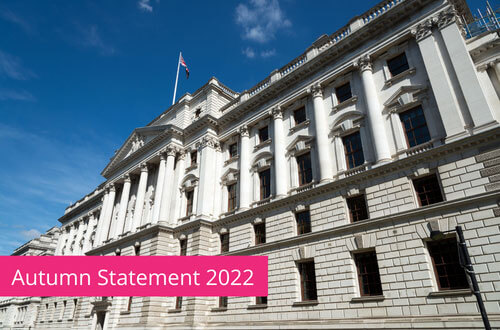Autumn Statement 2022: key tax announcements and commentary
We are pleased to bring you this summary of today’s Autumn Statement – separated into two parts: (i) individuals, and (ii) businesses.
Taxation of individuals
The (still fairly new) Chancellor, Jeremy Hunt, took charge of his first fiscal event since taking up that post today, and turned to taxation issues early on in his speech (at 11:40am). However, he only spoke about taxes for seven minutes. Having said that, his announcements covered most areas of private client taxation with both reduction and freezing thresholds and allowances. The measures impacting individuals are outlined below.
Reduction in the additional Income Tax rate threshold
The headline private client tax announcement by Mr Hunt was the anticipated and rumoured reduction in the threshold at which individuals pay the top rate of Income Tax. Since its introduction in 2009, the threshold at which the top rate of tax applies has remained at £150,000. This will reduce from 6 April 2023 to £125,140, over which individuals will pay tax at 45% (39.35% on dividends).
This will increase taxes for those with income over £125,140 by up to £1,243 a year.
Reduction in the dividend allowance
The dividend allowance which allows the first £2,000 of dividend income to be received free of Income Tax, will be reduced from 6 April 2023. This allowance will reduce to £1,000 from 6 April 2023 and then again to £500 from 6 April 2024.
Personal allowance and Income Tax thresholds
The personal allowance, up to which income is tax free, was set to be frozen at £12,570 until April 2026. This will now be frozen for a further two years until April 2028.
Similarly, the threshold at which the higher rate of Income Tax applies, £50,270, was set to be frozen until April 2026 and has also been frozen for a further two years.
In July, this year the National Insurance thresholds were aligned with the Income Tax thresholds. These have been confirmed to be frozen until April 2028 to match the measures announced for Income Tax.
The freezing of these thresholds and allowances has been dubbed in the press as ‘stealth tax’, as they raise taxes as income increases rather than on the introduction of the measure. As the allowance and thresholds were frozen until April 2026 previously, the impact of this measure will not have an impact until after April 2026.
Reduction in the Capital Gains Tax annual exempt amount
The first £12,300 of capital gains realised in a year by an individual are currently tax free as they are covered by the annual exempt amount. This exempt amount will be reduced from 6 April 2023 to £6,000 and then further reduced to £3,000 from 6 April 2024.
Trusts annual exempt amount is currently set at half the individuals allowance. It is expected that this will similarly reduce to £3,000 from 6 April 2023 and to £1,500 from 6 April 2024.
Inheritance Tax thresholds
The Inheritance Tax nil rate band is the threshold up to which no Inheritance Tax is paid on an estate. This has been frozen at £325,000 since April 2009 and has previously been announced to remain frozen at this level until April 2026.
As with the other allowances, this freeze has been extended by two years to April 2028.
The residence nil rate band allows an additional £175,000 of an estate to be free of Inheritance Tax when passing a main residence to a direct descendent, this has also been frozen until April 2028. This additional nil rate band is tapered for estates with a total value of over £2m.
With the price of property increasing, particularly in the south east, the freezing of these allowances to date and to April 2028 will result in more estates being subject to Inheritance Tax.
Stamp Duty Land Tax
In September, the nil rate threshold for Stamp Duty Land Tax (SDLT) was increased from £125,000 to £250,000; reducing the amount of SDLT payable on all residential property purchases over £125,000.
For first-time buyers the nil rate band was similarly increased from £300,000 to £425,000. This relief applies to first-time buyers who purchase a property under a specified value, that value was £500,000 and was increased in September to £625,000.
Mr Hunt announced today that this increase is temporary and will come to an end on 31 March 2025, at which point the previous thresholds will return.
Business taxes
Corporation Tax rate changes
Our expectations for the rate of Corporation Tax from April 2023 have been on a rollercoaster. Back when Rishi Sunak was Chancellor, he announced an increase to 25%.
More recently, In Kwasi Kwarteng’s “mini-budget”, this was supposed to be axed, such that the rate remained at 19% going forward. However, Jeremy Hunt took over from Kwasi Kwarteng and on 14 October 2022 announced that corporation tax will in fact be increasing to 25% from 1 April 2023.
No new changes to Corporation Tax rates were announced today. The corporation rates will remain as laid out in October’s Emergency Statement. After many years of enjoying Corporation Tax rates of 19%, (and unfulfilled promises of a reduction to 17%) only those companies with taxable profits of up to £50,000 or less will be eligible for the 19% rate from April 2023 onwards.
Companies with profits in excess of £50,000 will pay an effective tax rate of 26.5% on the slice of profits between £50,000 and £250,000 and 25% on profits of £250,000 and over. Where there are groups of companies, or companies under control of the same persons from April 2023, the profit bands will need to be divided by the number of companies to determine the applicable tax rate.
Research and development relief rates
Possibly the largest change announced today in relation to business taxation was in respect of the research and development (R&D) tax relief scheme.
This scheme has been widely criticised recently for the scope of error and potential fraud. The Chancellor has responded with three measures coming into effect for expenditure incurred after 1 April 2023:
- Reducing the SME R&D ‘enhancement’ amount from 130% to 86%
- Increasing the Research and Development Expenditure Credit from 13% to 20%
-
Decreasing the amount of repayable credit under the SME scheme to from 14.5% to 10%
The impact is not immediately obvious, because the impact will be different for profitable or loss making companies. However, it is clear that profit-making companies will be less worse off under these measures than loss-making companies.
By way of example, under the current rules, a company spending £100,000 on qualifying R&D spend would receive an additional £130,000 deduction to be relieved from its profits chargeable to tax. Under the new rules, that would be only £86,000. However, because the tax rate will rise for most companies, the difference may only be marginal: £24,700 to £21,500 (with a larger benefit for companies with profits between £50-250k).
The biggest impact for the SME scheme will be companies that make R&D related losses and have surrendered those losses for a payment from HMRC. Under the old scheme, a loss-making company with £100,000 of qualifying expenditure might be able to surrender it for £33,350 of cash from HMRC. However, the new rules will restrict this amount to £18,600.
There are further changes coming under the R&D scheme in April 2023 aimed at both tackling abuse and encouraging innovation, as well as a further consultation and it is likely further measures will be announced next year.
Annual Investment Allowance
The government has now provided more certainty for businesses by confirming that the Annual Investment Allowance (AIA) will remain at £1m permanently, rather than fluctuating from year to year as it has done in the past. This means that business owners will be able to continue claiming 100% tax relief on the acquisition of qualifying assets costing up to £1 million per year for the foreseeable future.
Unfortunately there has been no extension to the ‘Super Deduction’ which provides enhanced relief to companies at 130% on certain types of asset expenditure. This temporary allowance will cease on 31 March 2023, as originally planned. Companies may wish to consider bringing forward capital expenditure to take advantage of the Super Deduction where available.
Benefits in kind for electric vehicles
The taxable benefit rate for electric and ultra- low emission cars will rise by 1% per year from April 2025. By 2027/28 the benefit rate will be 5% for electric cars and 21% for ultra- low emission cars. Whilst this is still a much lower rate than the current rate of 37% for vehicles with emissions of over 170g/km, it is a notable increase from the current 2% rate. Businesses will therefore be paying more Employer’s National Insurance Class 1A Contributions as the value of the benefit increases.
Company Share Option Plans
As previously announced, from April 2023 two changes will be made to the Company Share Option Plans (CSOP) tax-advantaged share scheme.
Firstly, the maximum employee share option grant limit is to be doubled, meaning that options valued at up to £60,000 as at the date of grant will be eligible for the scheme. Secondly, the current rules restricting options to classes of shares which either give employees control of the company or are ‘open market shares’ majority held by outside investors will be scrapped. The relaxation of these rules will broaden the appeal of the CSOP in the future.
Raise in the National Living Wage
The National Living Wage is to be increased by 9.7% for individuals aged 23 and above, with effect from 1 April 2023. Rates for younger people are also set to increase by between 4.6% and 10.9%, depending on age. This will be another squeeze on business finances next year.
VAT
The Autumn Statement was very light on VAT announcements, with the exception that the VAT registration threshold will remain frozen at £85,000 until March 2026.
Where are we now?
For further information on how the measures announced today will impact private clients, as well as small, medium and large businesses, join our Tax Team's webinar .
If you have any questions about the above, or would like more information specific to your circumstances, please enter your email address below and we will get in touch:
Related View All














